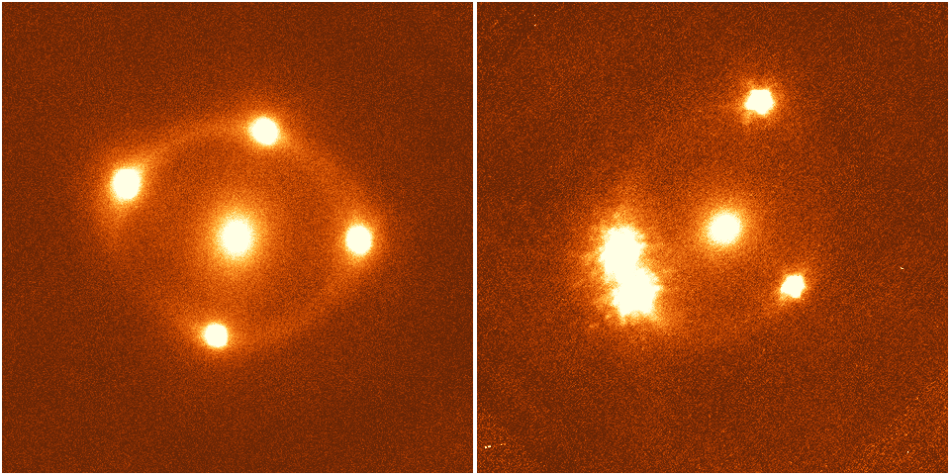Oct 24 2019
A team led by astronomers at the University of California, Davis provides new measurements of the rate of growth of the universe, adding to a growing mystery: Estimates of a fundamental constant made with different approaches keep delivering varying results.
 Images made with the W.M. Keck Observatory in Hawaii show how light from two distant galaxies is distorted into multiple images. UC Davis astronomers have made a new estimate of the Hubble Constant, which describes the expansion of the universe, by observing these distorted images. (Image credit: Chris Fassnacht/UC Davis)
Images made with the W.M. Keck Observatory in Hawaii show how light from two distant galaxies is distorted into multiple images. UC Davis astronomers have made a new estimate of the Hubble Constant, which describes the expansion of the universe, by observing these distorted images. (Image credit: Chris Fassnacht/UC Davis)
There’s a lot of excitement, a lot of mystification and from my point of view it’s a lot of fun.
Chris Fassnacht, Professor of Physics, UC Davis
Fassnacht is also a member of the international SHARP/H0LICOW collaboration, which carried out the measurement using the W.M. Keck telescopes in Hawaii. A paper describing the research has been published in the Monthly Notices of the Royal Astronomical Society.
The Hubble constant specifies the expansion of the universe, in kilometers per second per megaparsec. It enables astronomers to decipher the universe’s age and size, as well as the distances between objects.
Graduate student Geoff Chen, Fassnacht, and colleagues examined light from very distant galaxies, where the light is distorted and split into numerous images by the lensing effect of galaxies (and their related dark matter) between the source and Earth. By evaluating the time delay for light to reach through various routes via the foreground lens, the researchers were able to estimate the Hubble constant.
They used adaptive optics technology on the W.M. Keck telescopes in Hawaii to obtain an estimate of 76.8 km per second per megaparsec. As a parsec is slightly more than 30 trillion km and a megaparsec is a million parsecs, this is an incredibly precise measurement. In 2017, using the same technique and data from the Hubble Space Telescope, the H0LICOW team reported an estimate of 71.9.
Hints of New Physics
The new SHARP/H0LICOW estimates are analogous to those derived by a team headed by Adam Reiss of Johns Hopkins University (of 74.03), using measurements of a set of variable stars known as the Cepheids. However, it is extremely different from estimates of the Hubble constant from a completely different method based on the cosmic microwave background.
That technique, which was based on the afterglow of the Big Bang, provides a Hubble constant value of 67.4, assuming the typical cosmological model of the universe holds true.
An estimate made by Wendy Freedman and colleagues at the University of Chicago nearly closes the gap, with a Hubble constant value of 69.8 based on the luminosity of faraway supernovae and red giant stars.
Although a difference of 5 or 6 km per second spanning a distance of more than 30 million trillion kilometers might not seem much, it poses a challenge to astronomers. It might offer a clue to a probable new physics beyond the present knowledge about the universe.
Conversely, the inconsistency could be because of some unidentified bias in the approaches. Although some researchers had anticipated that the variances would vanish as estimates became better, the difference between the Hubble constant measured from faraway objects and that obtained from the cosmic microwave background appears to be getting stronger.
More and more scientists believe there’s a real tension here. If we try to come up with a theory, it has to explain everything at once.
Geoff Chen, Graduate student, UC Davis
The paper’s additional authors include Sherry Suyu, Inh Jee, and Simona Vegetti, Max Planck Institute for Astrophysics, Garching, Germany; Cristian Rusu, National Astronomical Observatory of Japan, Tokyo; James Chan, Vivien Bonvin, Martin Millon, and Frederic Courbin, Ecole Polytechnique Federale de Lausanne, Switzerland; Kenneth Wong, and Alessandro Sonnenfeld, Kavli Institute for the Physics and Mathematics of the Universe, Tokyo.
The other authors are Matthew Auger, University of Cambridge, UK; Stefan Hilbert, Exzellenzcluster Universe, Garching, Germany; Simon Birrer, Xuheng Ding, Anowar Shajib, and Tommaso Treu, UCLA; Leon Koopmans and John McKean, University of Groningen, the Netherlands; David Lagattuta, Centre de Recherche Astrophysique de Lyon, France; Aleksi Holkala, Tuusula, Finland; and Dominique Sluse, Leiden University, the Netherlands.
The research was sponsored by the National Science Foundation.